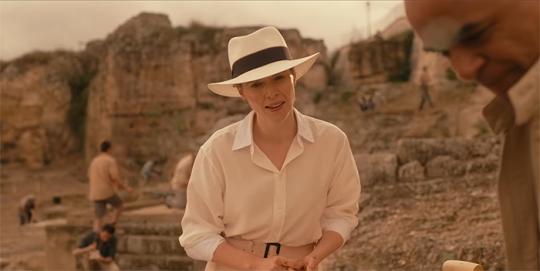#st thecla
Explore tagged Tumblr posts
Text
Beyond the fact that the heroine is a woman, the role of women in the ATh [Acts of Paul and Thecla] is underscored by numerous references to female supporters of [St] Thecla during her imprisonment and her trials in the arena. Thecla’s association with female characters extends even to her confrontation with the wild animals in the arena. Among all the beasts Thecla faces, a ‘fierce lioness’ befriends her, licking her feet during the procession before the games. Later in the arena, that same lioness defends Thecla against two male animals, a bear and a lion. The lioness’s battle with the bear and lion serves as a metaphor for Thecla’s own struggles against the opposition and antagonism of male characters in the story. By punctuating the battle between the lioness and the male beasts with the supportive responses of the anonymous ‘crowd of women,’ the story incorporates the lioness into that community of female supporters, and portrays the animal herself as a martyr for Thecla’s cause.
The Cult of Saint Thecla: A Tradition of Women's Piety in Late Antiquity by Stephen J. Davis
10 notes
·
View notes
Text
All Saints' Day Novena: Day 4
Time for my patron saint, Mar Taqla, aka St. Thecla!

Here's an image I painted of her! Do me a favor and don't look at the lion. What did I just say
There isn't very much writing attributed to St. Thecla. She was a friend of St. Paul, and she is called "Equal-to-the-Apostles." The book The Acts of Paul and Thecla is an apocryphal book because it promotes essentially female priesthood, and normally an apocryphal book is an apocryphal book to me, but, like. That's it? Idk I think it's something I'll check out in the future. It's linked below if you are curious.
I relate to St. Thecla in that she is delivered from many trials that would otherwise end in death. I feel like while I am not being persecuted, I get anxiety about my suffering before it even happens. But I've been trying to surrender to God's will before I undergo something, and most of the time, the thing I'm dreading doesn't happen. Not to say that they never will, but rather that I am warmed by the fire without having to step on hot coals. And that must have been something she experienced a lot. Mar Taqla, pray for me not only to be ready to give up comfort but to live in discomfort when I need to.
St. Thecla, pray for us!
1 note
·
View note
Note
Suggestion for the saint tournament: St Thecla and St Teresa of Avila!
Another vote for St Teresa of Avila!
As for St Thecla, she's a brand new nominee! She'll need a lot more propaganda to get her to the bracket!
1 note
·
View note
Text
“[x female saint] had to dress like a man to be taken seriously/be safe/do her job! Isn’t that terrible? 😟” well but have you considered that maybe she Wanted to dress like that?
#my post#thinking about st thecla and st Joan of arc#thinking of ‘in Christ there is neither male nor female’#thinking of this golden calf we’ve made of the gender binary#thinking about how so many stories written about female saints try to push them as ‘models of femininity’#thinking about how it feels disingenuous to treat every saint that doesn’t fit that worldview as#having been oppressed into presenting masculinely#thinking about how that feels like a prison. for them and for us.
37 notes
·
View notes
Text
Warrior Nun truly is the most fucked up fucking show in the whole fucking world isn't it
Thecla (Ancient Greek: Θέκλα, Thékla; Greek: Θέκλα; Turkish: Tekla) was a saint of the early Christian Church, and a reported follower of Paul the Apostle. The earliest record of her life comes from the ancient apocryphal Acts of Paul and Thecla.

In one scene, female beasts, particularly lionesses, protected her against her male aggressors.



It is also said that Thecla spent the rest of her life in Maaloula, a village in Syria. There, she became a healer and performed many miracles...


...but remained constantly persecuted.


In one instance, as her persecutors were about to get to her, she called out to God, a new passage was opened in the cave she was in, and the stones closed behind her.


Around AD 280, Thecla features as one of the characters in Methodius of Olympus' Symposium, in which she displays considerable knowledge of profane philosophy, various branches of literature, and eloquent yet modest discourse. Methodius states that she received her instruction in divine and evangelical knowledge from Paul, and was eminent for her skill in sacred science ("Logos 8").




According to some scholars, Thecla's story inspired many later stories of women saints who dressed as men



All of these women were empowered by Thecla, a woman who did things that not many women would ever dare to do
In Spanish-speaking countries, she is also facetiously counted as the patron saint of computers and Internet, from the homophony with the Spanish and Catalan word tecla ("key").[citation needed]



(text on Thecla of Iconium taken from Wikipedia)


#jillian salvius#warrior nun#thekla reuten#I'M NOT SAYING THIS MEANS ANYTHING I'M JUST SAYING#[insert i'm not saying it's aliens but it's aliens meme here lol]#the craziest thing about it is that i wasn't looking for it. i was reading on tiepolo#as in yes art history. then a painting about a st thecla showed up in the text and it all snowballed from there#you have to admit that some of these parallels (or quasi-parallels anyway) between jillian and st thecla are... uncanny#funny and or misc#no i am not putting this in my analysis tags because this is for the lols (or is it)#editing this to add in the tags that sylvia de fanti is a leo#so a lioness in her own right so to speak. when lionesses were the ones to protect st thecla#i mean if you really want to fuck it up... thekla is a virgo. jillian as a VIRGIN MARY figure anyone...?#if we're gonna mix up real life and fiction might as well do it in style huh#this fucking show sdkljfghsdkjghkjsg#OKAY FINE I AM PUTTING IT IN MY PERSONAL ANALYSIS TAG#exercises in observation
110 notes
·
View notes
Text
al things considered — when i post my masterpiece #1231

first posted in facebook october 25, 2023
julia thecla -- "mary in blue shoes" (1939)
"THE MAGIC POOL go in bowed silence to the dark pool others are there, heads bare it is holy water stare into the magic circle … sleep the hypnotic sleep from which the word will awaken you … the word forgotten by the hypnotist" … julia thecla
"her ethereal and sensuous portrayal of dreams, fairytales, and planetary realms were extraordinary explorations of alternative social orders" … depaul art museum
"julia thecla is the mystery girl of chicago art — shy, self-effacing, seldom saying more than half a dozen words to anyone, gliding abruptly but quietly away after briefly acknowledging an introduction to a stranger. she is almost as evasive an enigma, as the original thecla for whom she is named – that st. thecla who became infatuated with the eloquence of st. paul and followed him everywhere disguised as a boy, possibly acting as his secretary" … c.j. bulliet
"look deep into my eyes mary in your blue shoes … deeper … deeper … you are getting drowsy … very drowsy … sleep mary sleep" … bunny rabbit [i.e., al janik]
#julia thecla#mary in blue shoes#the magic pool#the hypnotic sleep#depaul art museum#dreams#fairytales#chicago#st. thecla#c.j. bulliet#bunny rabbit#al things considered
2 notes
·
View notes
Text
Does he mention Thecla anywhere in the text? Or is her existence too dubious? (Thecla being an early female saint who followed him thanks to the ‘no sex / marriage teachings who is very assertive. And still a thing in some Christian communities.)
youtube
i finished reading damascus by christos tsiolkias (his novel about the apostle paul and early christianity) and was very pleasantly surprised by how it manages to be such a nuanced and complex look at such a controversial figure without descending into the saccharine preachiness of Christian fiction (and in fact, being written by someone who is not a Christian and also filled with enough shits, fucks, cunts, and reference to arse-fucking to instantly kill the average Christian fiction writer)
he manages to balance contrasts very effectively; a cruel, profane world of crucifixion and rape with a genuinely subversive religion of love and solidarity; a Paul flowing with genuine kindness and faith but also struggles with streaks of pride and jealousy.
but what impresses me most of all is the way the novel holds both Paul's apocalyptic gospel of resurrection in a world to come and its radical rejection of the injustice of this world with Thomas' naturalistic gospel that the kingdom has come and is among us already in Jesus' teaching. especially the way Tsiolkias acknowledges that even as Paul's gospel sits awkwardly with our modern scepticism it has heirs in any revolutionary tradition that wishes to change the world; it is this gospel that stands in condemnation of the systems of the world as they stand, and that spread the teachings of Jesus to the entire world (notably Damascus takes the interpretation that none of the other apostles bar Paul would fellowship with Gentiles). it would have been very easy to tap into the zeitgeist of scepticism and write a novel where Paul is a charlatan or crazy fundamentalist, and the gospel of Thomas marginalised and ignored as heretical and Gnostic is rather the true faith buried by orthodoxy. Paul is a very acceptable scapegoat to bash; if we can blame all the uncomfortable bits of the Bible on him (or the bloodthirsty and primitive Old Testament) we can maintain an unsullied image of pure Christianity. [and i don't mean to say this is entirely unjustified, especially given the way evangelicalism in particular loves to deploy isolated verses rather than entire texts! When your primary mode of engagement with him is not actually reading his epistles as works of literature, but throwing Romans 1.27 at gay people to convince them to stop being gay 100 times, that is naturally going to deeply warp your perspective of how much of his corpus is actually problematic (which, imo, when we account for 1) cultural norms re homosexuality and pederasty 2) the fact about 3-6 'Pauline' epistles were probably not written by him and 3) some verses possibly being interpolations, is really not that much).] But such a novel purporting to expose Paul as a fundamentalist charlatan would be just as didactic and simplistic as pious Christian fiction where Paul can do no wrong and harbour no doubts and is a direct mouthpiece for 21st-century evangelical doctrine. And so I very much appreciate the thought and empathy Tsolkias puts into this novel to understand Paul, rather than taking a few soundbites as an excuse to dismiss the man entirely. His Paul is flawed - a man who falls victim to jealousy, who sometimes makes his heart stone to avoid doubt - but also a man who believes in friendship and love across barriers of male and female, slave and free, Jew and Greek, one who hopes that this world mired in empire and oppression and crucifixion need not be the only way. and also a man who has a homoerotic relationship with Timothy that also has v queer-coded parallels in him bringing home an uncircumcised Gentile to the apostles in Jerusalem who he fears will reject this pagan. which is cool imo
#st paul#paul the apostle#christian#queer christian#christianity#religion#damascus tsiolkias#thecla#Youtube
30 notes
·
View notes
Note
Who do you think is the Saint of transitioning? Like, in general
perhaps either St. Marinos the monk or St. Wilgefortis... or even St. Joan of Arc, St. Thecla, St. Eugenia...
(Kittredge Cherry from qspirit.net has some very extensive lists!!!! also, i highly recommend her website. she's so cool <3)
#i think it all depends who calls most to you#i'd honestly think St. Marinos is the one that calls to me most#but idk#thoughts#anon#anon questions#ask away
82 notes
·
View notes
Text

Saint Thecla of Iconium
1st Century AD
Feast Day: September 23
Saint Thecla, a virgin and native of Iconium was popular in the early Church. She was so impressed by St. Paul the Apostle’s preaching that she became his follower and a perpetual virgin. Legend has it that because she was a Christian, attempts were made to torture her by fire, rape, and eaten by wild beasts, yet she was miraculously protected all three times showing a martyr’s heroic faith. Eventually she lived as a hermit though persecuted until her death. She is called the protomartyr among women.
Prints, plaques & holy cards available for purchase. (website)
46 notes
·
View notes
Text

Mosaic of St. Thecla from the apse of the Euphrasian Basilica, 13th century
3 notes
·
View notes
Text
Catholic Saints fancast: Anna Magnani as St Rita of Cascia, Lakeith Stanfield as John the Baptist, Anne Dowd as Margaret Pole, Nicola Coughlan as Therese of Lisieux, Mia Goth as Clare of Assisi, Irene Pappas as Teresa of Avila, John C Reilly as Thomas Aquinas, Drea de Matteo as Mary Magdalene, Michaela Coel as St. Thecla, Jennifer Coolidge as Margaret of Cortona, Tony Leung as Mark Ji Tianxiang, Steve Buscemi as Augustine of Hippo.
5 notes
·
View notes
Text
What I really want is a video game where I get to play as St Thecla, wandering the open world of Mediterranean antiquity. Major quests are in Antioch, Galatia, Phillipi, Corinth, and Ephesus. Thecla (or Phoebe? or Junia?) is tasked with securing manuscripts of foundational documents as Peter and Paul await martyrdom in Rome. The final boss is Emperor Nero, but before he can be defeated, Thecla must first subdue Simon Magus, a “henchman” protecting the Emperor. Even though Thecla, whose “physical” weapon is a swinging thurible, will not succeed in halting the martyrdoms of P+P, she eventually defeats Nero, who, as his physical form deteriorates, reveals that the power behind Empire is the Spirit of Antichrist, active in every age and recognizable because of its compulsion to incarnate wealth, enslavement, confusion, exclusion, and scarcity.
After her ultimate victory, Thecla founds a monastery in the desert where she will train the next “warrior” in the power of love, prayer, and weaponized incense.

13 notes
·
View notes
Text
EMBER Saturday – Fast & Abstinence, Nuestra Senora de Valvanera / Our Lady of Valvanera, Spain (9th Century), St Pope Linus, St Thecla and the rest of the Saints for 23 September
EMBER Saturday – Fast & Abstinence – In case you have forgotten about Ember Days as they are not promoted or encouraged since Vatican II, here is a reminder:https://anastpaul.com/2020/12/16/today-is-an-ember-day-did-you-remember/ Nuestra Senora de Valvanera / Our Lady of Valvanera, La Rioja, Spain (9th Century) – 23…

View On WordPress
2 notes
·
View notes
Text
Today the church remembers the Martyrs of Memphis, Sr. Constance, Nun, and Her Companions.
Orate pro nobis.
Late in the summer of AD 1878, yellow fever struck Memphis, Tennessee. The populace all tried to flee, leaving behind those unable to escape, mostly the poor and those already ill. Within 10 days of the first yellow fever death in Memphis, more than half the population fled the city in a panic. They left “by every possible conveyance — by hacks, carriages, buggies, wagons, furniture vans, and street drays,” wrote Keating. “By anything that could float on the river, and by the railroads. The stream of passengers seemed endless, and they seemed to be as mad as they were many.”
Left behind were still some 20,000 men, women, and children, but Memphis faded into a ghost town. Shops and offices were boarded up, houses locked and shuttered. An eerie silence smothered the city, broken only by the occasional booming of cannons (fired to break up the “poisons” in the air), and the steady clop-clop of doctors’ wagons or carts hauling caskets. At night, smoldering fires of burning bedding and clothing — the last belongings of fever victims — lit the yellow-armbanded Howard Association members, who scurried from house to house aiding the sick.
Victims dropped dead in the streets, and bodies were discovered each morning in the city’s parks. Entries in the sister’s journals describe an abandoned town with the bodies of the dead lying where the fell, children in homes with their dead parents…scenes of pure horror. Sister Constance wrote: “Yesterday I found two young girls, who had spent two days in a two-room cottage with the unburied bodies of their parents, their uncle in the utmost suffering and delirium, and no one near them. It was twenty-four hours before I could get those fearful corpses buried, and then I had to send for a police officer … before any undertaker would enter that room.”
The Episcopal Cathedral of St. Mary’s, and its adjacent Church Home, were in the poor part of town, the center of the most infected area, and became shelters for victims. The cathedral staff and nuns of the Sisters of St. Mary, who operated the Church Home, faced enormous burdens in caring for the sick and dying. The Cathedral of St. Mary, then a plain wooden church, stood as a beacon of hope amid the gloom, and two priests there — Fr. Charles Parsons and Fr. Louis Schuyler — also played heroic roles during the epidemic. They joined dozens of other church members throughout the city who, along with the Howard Association, died at their posts during the ordeal.
Some of the sisters were on retreat in Peekskill, New York, when the epidemic broke out, and instead of keeping a safe distance they rushed back to Memphis. When the news of the deaths of the local priests got out, over 30 priests from all over the nation volunteered to come to Memphis. Father W.T. Dickinson Dalzell came from Shreveport, La., since he had already survived the disease and was immune—he was also a trained physician. With his arrival, daily Eucharist resumed and the Sacrament was carried to the dying Sisters.
Sister Constance was the first of the nuns to be stricken. As she died on September 9, her last words were “Alleluia, Hosanna,” simple words of praise remembered and inscribed on the cathedral"s high altar.
Sister Constance’s companions in service to the sick and dying, Sisters Thecla and Ruth, soon followed her to the grave, as did Sister Frances, headmistress of the Church Home. She had nursed some thirty children at one time and had watched twenty-two die. Fr. Louis Schuyler, a chaplain to the Sisters of St. Mary, also died of the fever, as did Fr. Charles Parsons. Fr. Parsons was blessed with a vision of heaven as he lay dying and his last words were, “Lord Jesus, receive my spirit.”
When winter came and the mosquitoes died off, the epidemic ended, 200 towns and cities across the South lay wasted. Yellow fever had infected more than 100,000 people, causing some 20,000 deaths — more than 5,000 in Memphis alone.
5,150 people died in the Memphis Yellow Fever epidemic of 1878, and many of them were formerly healthy people who had stayed to help the sick until succumbing themselves. The city buried 1,500 of its dead in a mass grave on a bluff overlooking the Mississippi -- and pretty much forgot about them until January 3, 1971, when the grave site became Martyrs Park.
On this day we honor those who gladly risked their own lives in the name of Jesus in order to save the lives of many and to assuage the final suffering of others.
Embolden us to work for the healing of all those in need, seeking to love others as you have loved us, Lord Christ.
We give you thanks and praise, O God of compassion, for the heroic witness of Constance and her companions, who, in a time of plague and pestilence, were steadfast in their care for the sick and dying, and loved not their own lives, even unto death; Insipre in us a like love and commitment to those in need, following the example of our Savior Jesus Christ; who with you and the Holy Spirit lives and reigns, one God, now and for ever.
Amen.

2 notes
·
View notes
Text

Ammas and Abbas - early founders
DESERT FATHERS AND DESERT MOTHERS
The persecution of Christians in the Early Church led to an exodus of believers to the deserts of Syria, Egypt and Asia Minor. These Christians became ascetics. The Christian women became known as mothers (ammas) and the Christian men as fathers (abbas). They were the early founders of what would become known as the desert movement.
The desert was selected as a place to seek and hunger after God. These ascetics practised detachment from earthly comforts and were devoted to the pursuit of spiritual growth. [1] Their purpose was to live as hermits in the desert, to live a solitary life solely dedicated to God.
Anthony of Egypt and Pachomius
During the late 3rd century a Christian man named Paul, living in the city of Thebes in Egypt, was forced into the desert during the Decian persecution. He lived in a cave while awaiting the end of the persecution, and found he enjoyed the solitude and freedom to fast and pray. Paul embraced life in the desert and lived in that cave for many more decades as a hermit dedicated to the worship of God. [3]
The famous desert father Anthony of Egypt gave away his inherited riches, and retired to a hut in the desert. Anthony dedicated his life to fasting and prayer, living a life of poverty to the glory of God.
An Egyptian from Thebes named Pachomius (292-348) was one of the founders of modern communal monastic life. When he was 20 years old, he endured imprisonment and received kindness at the hands of Christians. Pachomius became a Christian after his release from prison in c. 314. [2]
Father of Cenobitic Monasticism
Saint Pachomius felt drawn to the Desert Fathers and built his cell in the desert near St Anthony. He realized that most of the men who desired Anthony's eremitic life could not live in such solitary isolation. He decided to build 10 to 12 room houses where men could live in individual rooms and undertake practices of holiness. Thus Pachomius is called the 'Father of Cenobitic Monasticism.' All these centuries later, there are still Christian monasteries scattered throughout the Sahara Desert in Egypt. [2]
Desert fathers
Other desert fathers include Saint Macarius of Egypt, Abba Agathon, Saint Amun, Saint Basil of Caesarea and Saint Moses. Those who were highly influenced by this early monasticism were Saint Athenasius of Alexandria, Saint John Chrysostom, Saint Hilarion and Saint John Cassian. Saint Benedict later developed the Benedictine rule for monasticism based on the writings of the early desert fathers. Thus most modern-day religious orders can trace their spiritual heritage to Egypt. [3]
Saint John Cassian brought the wisdom of the desert fathers to Europe, and his influence spread as far as Ireland. Thereafter, Ireland's own form of monasticism developed, largely based on the writings of Cassian and example of Saint Anthony. [3]
Desert mothers
Many women were leaders in the desert reform. Syncletica, Thecla, Macrina, Paula and Pelagia are some of the mothers (abbas) who shaped the spirituality of the desert movement.
Saint Syncletica and her sister
Syncletica was born in the 5th century to a noble Christian family in Alexandria, Egypt. She moved with her blind sister to the desert outside Alexandria to live in simplicity and prayer. Other women soon followed Syncletica, and she served as their spiritual mother. She called her followers to empty themselves of attitudes which did not spring from closeness with Christ. Syncletica loved learning, as she believed that ignorance hindered spiritual growth.
Saint Macrina
Macrina was the elder sister of two bishops, Gregory and Basil. She taught that humility and love were the goals of philosophy. Macrina turned the family home into a monastic community where all possessions were shared. Her holy life attracted many followers.
Saint Pelagia
Saint Pelagia was a woman who dressed as a monk in later years. An actress in her earlier life, Pelagia heard Bishop Nonnus preach in Antioch. She gave away all her possessions, and just before her baptism, she left wearing Nonnus' cloak, never to be seen in Antioch again. Pelagia assumed the identity of a monk, and retreated to the desert.
Years later, one of Nonnus' monks travelled to Jerusalem to pray with a holy man name Pelagius. He returned a few days later to find that Pelagius had died. In preparing Pelagius for burial, he found that Pelagius was actually Pelagia, a woman.
Saint Paula
Paula (347-404 AD) was a desert mother. After the demise of her husband, Paula went on pilgrimage to the holy sites. Concluding her journey, Saint Paula decided to remain in Bethlehem to develop a monastery and spiritual retreat with St Jerome. Paula and Jerome built a double monastery in Bethlehem - one for Paula and her nuns, the other for St Jerome and his months. The addition of a roadside hostel was also constructed to serve as an economic source to fund the monasteries. [4]
Many abbas and ammas
There were many desert fathers and desert mothers. Their words of wisdom have a lot to offer us in today's world. Further blog posts will follow in which the serenity of some of the holy words will be reflected.
Influence of the desert movement today
The influence of the desert fathers and desert mothers can still be felt within our world today. At times, yearning for a more peaceful life within the hustle and bustle of our constantly changing world may be experienced.
Live the simple life
The example of the early abbas and ammas offer inspiration if we wish to live more simply, think more slowly and clearly, eschew over-reliance on earthly goods. Further, their example helps us to be resilient and self-disciplined. Following the holiness of the frugal monastic lifestyle helps us to offer daily difficulties as sacrifices to God for the advancement of His Kingdom here on earth.
Emulation of the example of regular prayer of the desert fathers and mothers, proves a strong spiritual support. It is holy to dedicate time each day for prayer and silence to still your thoughts, refresh your mind and strengthen your relationship with God.
[1] Women's history month: Early Church Women and Desert Mothers
[2] Sandra Sweeney Silver. Early Church History: Who were the Desert Fathers?
[3] Philip Kosloski. Who were the Desert Fathers and why do they matter?
[4] Paula of Rome
With thanks to cbeinternational.com, earlychurchhistory.org, aleteia.og and wikipedia.org Paula of Rome
Image courtesy of Freepik AI generated content with CN Whittle
0 notes